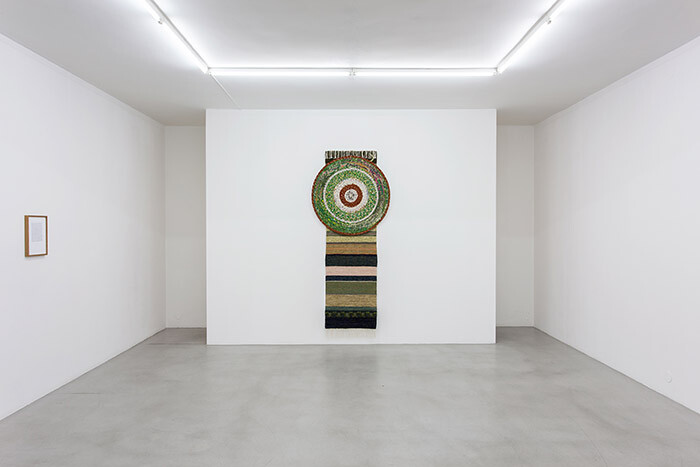At one point in his 1960 book, Crowds and Power, Elias Canetti surveys “the symbology of nation states.” The English, he writes, see themselves as captains surrounded by sea; the Swiss are a single body linked beneath mountain peaks. Germans, in turn, assume symbolic form as an army, which Canetti calls a “marching forest.” “To this day,” he writes, the German “loves to go deep into the forest where his forefathers lived; he feels at one with the trees.” In such passages, Canetti not only maps landscape onto culture; he also implies how landscape can be molded to fit nationalist ends.
Swedish artist Ann Böttcher has spent years working through this implication. Her 2008 show at Galerie Nordenhake, in Berlin, directly referenced Walther Schoenichen, a German biologist and environmentalist who also served the Nazi Party as Director of the Reich Forest Ministry. Alongside photogravures of pages from Schoenichen’s 1934 book, Urwaldwildnis in deutschen Landen [German Primeval Wilderness] were delicate graphite renderings of pine trees that Böttcher likened to German soldiers (The Dürer Drawings (after Pine tree 1495-97), 2006–2008).
In “Transmigrations (Bookshelves, a cannon emplacement and a Mercedes),” Böttcher’s first solo show at Nordenhake’s Stockholm space, the artist continues this inquiry, now focusing on the 1940–45 German occupation of Norway. Many of the works on view were originally commissioned for the 2013 Lofoten International Art Festival in Svolær, Norway, a strategically important location during the Second World War. Working with William Hakvaag, the founder of the Lofoten War Memorial Museum, Böttcher discovered several remnants of the occupation, including the former Gestapo Headquarters, which had been sited in a white building adjacent to the local library.
The artist responded to these discoveries by drawing the spruces surrounding the building, as seen through the library windows. For the festival, she framed and hung these drawings on bookshelves that themselves afforded views of the trees. At the War Memorial Museum, Böttcher mounted two textiles based on the design of a local German cannon emplacement and a rack of wartime coats respectively, which she had discovered in Hakvaag’s office. Entitled Transit Portal (The War Museum/Svinøya, Svolvær, Lofoten, NO) (2013), the work, according to Böttcher, was a channel “offered to the spirits haunting the museum.” In a personal e-mail to the artist, Hakvaag confirmed that it “was accepted.”
Given how significantly these projects draw on the history of Svolær, the move to Stockholm could seem ill-conceived—a mere reprisal of a founding debate in site-specific art. However, Böttcher distinguishes herself by having a dynamically archaeological practice, remaining open to events that extend beyond her work’s specific research period.
In this case, Böttcher learned that the library in Svolær would be relocated in 2015. The shelves were due to be scrapped, so she obtained permission to take them with her. Concurrently, the land between the library and the former Gestapo headquarters was being turned into a park—all of the coniferous trees had already been uprooted. When Böttcher returned to Svolær to collect the shelves, she also worked with a local photographer to capture images of the spruce trunks, which lay stacked around the library (Returning to Svolvær, October 2014 (The Tree Trunks), 2014). In a stroke of luck, the photographer recalled taking a picture of the former headquarters in 1982, with a white, German-made Mercedes parked in front. He gave the negative to Böttcher.
A full account of these references and histories could exhaust paragraphs more. To her great credit, Böttcher introduces them into her Stockholm show elegantly and economically. Alongside the “portal” and the shelves—now stripped of books—are the aforementioned photographs, a print of Hakvaag’s e-mail, two research images, and three texts (written by the artist), which poetically reflect on the narrative to date. As viewers, we are quickly sensitized to what we lack, a year later and many miles from Norway. We can’t speak to the experience, for example, of standing in a haunted museum as ghosts of soldiers pass through Böttcher’s portal. But a year later and many miles from Norway, we also gain from this critical distance and breadth, free to imagine the tree, the books, the thickness and scent of the museum air—freed from the romance of site-specificity, which, echoing Canetti, can sometimes mold localities to fit touristic ends.
In one of her exhibition texts, Böttcher defines transmigration as “the passage of a soul after death into another body.” While an obvious metaphor for the artist’s “marching forest,” the term also frames her process at large: as not one but a series of passages, of little deaths and reanimations, and of histories constantly in search of forms.










